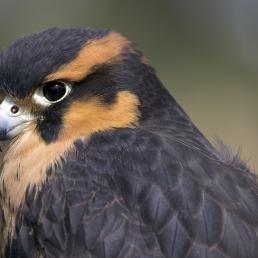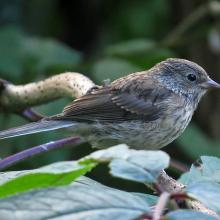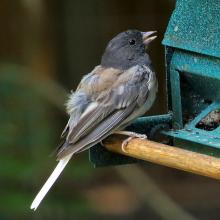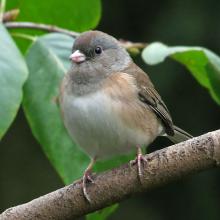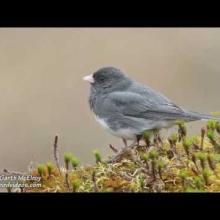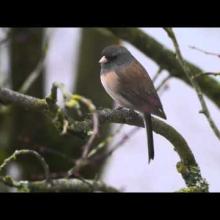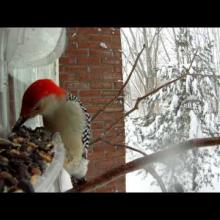

Join BirdNote tomorrow, November 30th!
Illustrator David Sibley and actor H. Jon Benjamin will face off in the bird illustration battle of the century during BirdNote's Year-end Celebration and Auction!
It’s junco season in North America. Flocks of these white-bellied snowbirds are kicking and scratching on woodland edges and beneath feeders from southern Canada to Mexico. On warm winter days, the males may even break into song. But songs and calls aren’t the only way Dark-eyed Juncos communicate. Researchers have discovered that the oil juncos use to keep their feathers in top condition is aromatic. And the oils produced by males and females have different chemical compositions. It turns out our wintertime juncos, so familiar and so modest, create a sensory world of their own.
BirdNote®
Eau de Junco
Written by Rick Wright
This is BirdNote.
It’s junco season over much of North America. Busy little flocks of these white-bellied snowbirds are kicking and scratching on woodland edges and beneath feeders from southern Canada to Mexico.
[Dark-eyed Junco (77274) 00:28-00:43)]
Birds chip and tseet at each other almost constantly as they feed. And on warm, bright winter days, the males may even break into light, loose trilling song.
[Dark-eyed Junco (59856) 00:18 and following)]
But songs and calls are not the only way juncos have to communicate.
[Dark-eyed Junco (77274) 00:05-00:16)]
For centuries, the party line has been that birds don’t have much of a sense of smell. There are exceptions — the Turkey Vulture, to name an obvious example. But for the most part it has been believed that, over their evolutionary history, birds have “opted” for highly developed senses of sight and hearing, leaving no significant room in the brain for smell.
[Dark-eyed Junco (77274) 00:05-00:16)]
However, researchers have discovered that the oil juncos use to keep their feathers in top condition is aromatic. What’s more, the oil produced by males and the oil produced by females have different chemical compositions. The most “masculine”-smelling males are most attractive to breeding females, while the most “feminine”-smelling females have the best luck with males.
[Dark-eyed Junco (77274) 00:28-00:43)]
Turns out our wintertime juncos, so familiar and so modest, create a sensory world of their own.
For BirdNote, I’m Michael Stein.
###
Bird sounds provided by The Macaulay Library of Natural Sounds at the Cornell Lab of Ornithology, Ithaca, New York. Dark-eyed Junco [77274] by Wilbur L. Hershberger; Dark-eyed Junco [59856] by William W.H. Gunn.
BirdNote's theme music was composed and played by Nancy Rumbel and John Kessler.
Producer: John Kessler
Executive Producer: Dominic Black
© 2017 Tune In to Nature.org February 2017/2019 Narrator: Michael Stein
ID# DEJU-05-2017-02-17 DEJU-05
